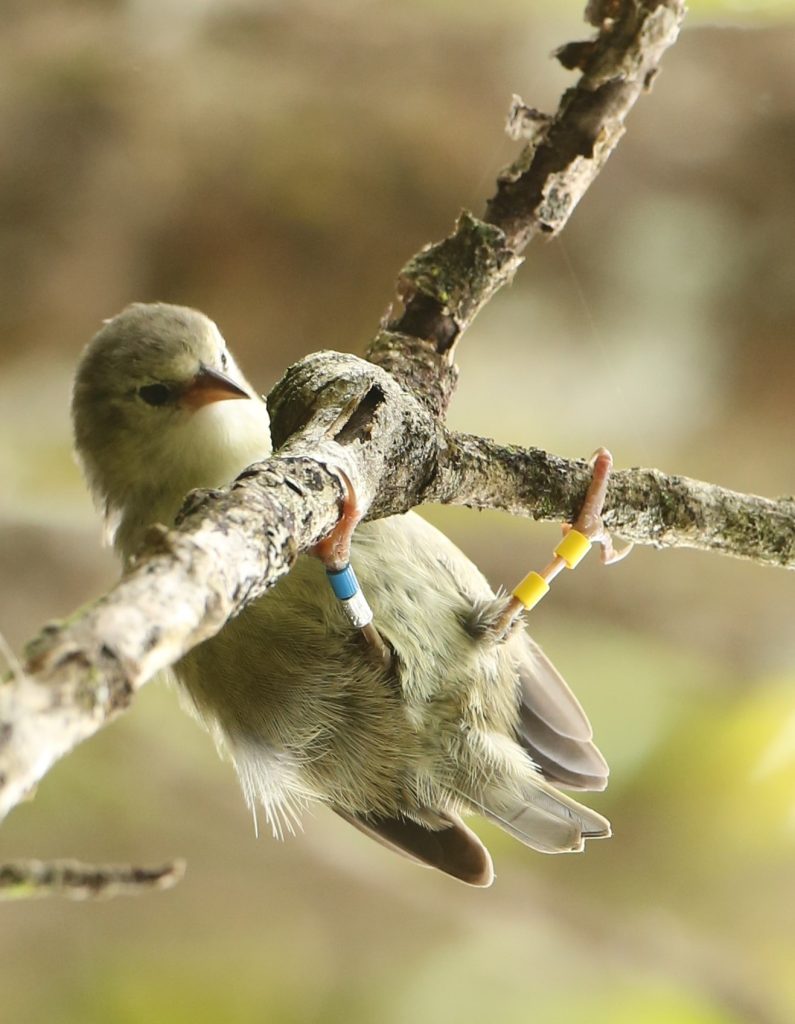Could this be the last season Hawaiian honeycreepers survive in the wild on Kauaʻi?

From a remote camp, perched on a narrow 3,000-foot cliff near the top of Wainiha Valley, field supervisor Justin Hite and his team from the Kaua‘i Forest Bird Recovery Project are in the midst of another field season of trying to save ‘akikiki — the diminutive native Hawaiian honeycreeper.
But it may be the last season for ‘akikiki in the wild on Kauaʻi.
“This is one of the last places where we’re still seeing a ton of native forest birds, where everywhere else, just in the last couple of years they’ve quickly and suddenly vanished,” Hite said. “And we think it’s because of mosquitoes.”
Hite and the team were on an eight-day egg collection trip.
The usually upbeat and hopeful Hite has lost some of his optimism for the species. Other members of the recovery project have been documenting increases of disease-carrying mosquitoes on the Alakaʻi Plateau.
Regulators are on the verge of approving landscape control of mosquitoes in the mountains of Kaua‘i using the Incompatible Insect Technique to reduce the likelihood that forest birds will be impacted by avian malaria that is carried by female mosquitoes.
While permitting and approval is underway, the forest bird team continues work in some of the toughest terrain around.
Robby Kohley, director of Aviculture with Pacific Rim Conservation, is the on-site expert working with the team in the Mohihi region of the plateau.
“Each project comes with a different set of challenges,” he said. “The logistics problems of this project are quite high. Between the weather [mostly wet, muddy and incredibly steep], and the lack of luck ‘akikiki are having with nests this year, I’d say this one ranks really high on the challenge scale.”
Since late January the recovery teams have been flying into the field, hiking to field camp and then from there trudging through knee deep mud on unimproved pig trails to reach ‘akikiki nests that had been previously spotted.
Using a camera mounted on a long pole, they’re able to see the condition of the tiny eggs. If they appear to be in good shape, they then rig up a tethered ladder system to get a team member as high as 48 feet into the forest canopy to collect them.
So far, they’ve successfully rescued 10 ‘akikiki eggs that are placed in a portable incubator and carried, ever so gently, up the trail to camp. They’re then flown out to a brooder house in Koke‘e State Park and eventually to the San Diego Zoo Wildlife Alliance Keauhou Bird Conservation Center at Volcano on the Big Island.
Hite notes ‘akikiki in the wild are very good at breeding. However, if avian malaria doesn’t strike them down first, rats are picking them off one-by-one.
“This year is an out-of-control level of nest failures,” Hite said.
Typically, the team finds 30 nests each season and almost all of them would fledge young into the wild.
“We spotted a female ‘akikiki sitting on two eggs and when we came back two days later to collect the eggs, we found broken, rat-chewed eggshells on the ground,” he said.
Now the field team has the added pressure of trying to control the rat population by setting out dozens of rat traps.
The team also deals with opposition to IIT from a small number of opponents.
“These birds are only here,” Hite said. “They’ve been here the whole time, long before people arrived in the islands. They’re quiet, unassuming and wonderful. If we lose them, it’s a huge loss. It’s terrible.”
To learn more, click here.



